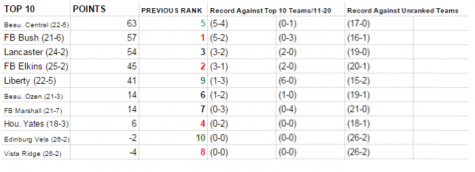Sports opinion: The downfall of high school rankings

Senior guard Bradley Saad passes in the ball after a foul on the baseline.
The idea for this column came on a normal day.
As usual, I check the Texas Association of Basketball Coaches’ rankings to see how the school’s respective basketball teams were doing. After looking at girls’, I looked at the boys’ ranking. They were 9th, after defeating two ranked teams.
I scrolled down, and saw Little Elm at 16. A team that lost by 15 to Liberty, and finished that week 0-1, went up two spots in the rankings.
Rankings are prominent throughout college sports. The College Football Playoff is all determined by rankings. Same with March Madness, which is based off a combination of RPI, strength of schedule, good wins, bad losses, and more.
The difference between college and high school is the availability. You can see any college game anywhere, archived online, or live on TV. Highlights are shown on every nightly sporting channel, to the masses of audiences.
I guarantee high school coaches do not have the time or resources to watch every single game of high school basketball in the state of Texas. It’s ridiculous to even believe they get close to that number.
How can you judge a school if you haven’t watched them? Off hype? Off what they did in previous years? Off random box scores?
I understand it’s tough, but there has to be a better way than what we’re looking at. In what kind of system does a team move up when losing?
Well instead of just ranting on it, I decided to take initiative.
Taking a page out of March Madness, I devised my own ranking system based off what the selection committee looks at when selecting the field of 68 teams.
This system takes into account four factors; margin of victory, good wins, good losses, and bad losses.
Looking through the current (as of February 1st) top 10 team’s schedules, I awarded 10 points for a victory over a top 10 team, 5 for a win over an 11-20 ranked team, and 2 for a win over a top 20 team. A loss against a top 10 team would also give you 2 points, while a loss against a 11-20 ranked team gave you only 1. District wins by over 20 would also give the team a point.
The only negative would be what I categorize as a ‘bad loss’. A bad loss would be a loss against any unranked team. This would dock the team 5 points.
I plotted every one of those occurrences on this spreadsheet, added up all the points the teams obtained, and re-ranked the teams based off of my scale.

The big movers were Beaumont Central and Liberty. Each have had several games between ranked opponents. Central has played nine teams against the top 10 of the 4A, 5A, 6A, and private school rankings, and defeated five of them. Liberty has had some tough losses against Lancaster and Cedar Hill, each one of the top teams in their division.
Teams should be rewarded for their attempts to play tough teams. That’s a way that these rankings can encourage schools to play in big name tournaments and against big name teams.
I understand that margin of victory is a very useful tool in seeing how a team fares, but I truly do not think a team has challenged itself unless it plays the top competition.
It also seems as if there’s a major bias toward the schools in the Houston area. While obviously, District 9-5A isn’t the strongest district out there, it still should command some sort of respect. The wins that Liberty has had over schools such as Little Elm and The Colony have barely been rewarded.
Rankings are tough. It wouldn’t be a matter of if someone could create a chart like this, but if they wanted to actually to take the time to create a chart for so many schools in the state.
I think a system rewarding teams playing tough competition is a major plus. Encouraging teams to schedule stiffer competition would benefit many. It would provide for entertaining games between great teams, and would help give players experience for potential playoff clashes against similar caliber opponents.
I wouldn’t even start ranking teams until before district. Judge from the pre-season play and tournaments to create a pre-district play Top 25, and then go from there. Let team play some games and let the point system do its magic.
Currently, the way rankings are done don’t seem to portray an accurate system. The only rankings I would trust are Dallas Morning News’ Sportsday Rankings, which rank teams in the area, who have played similar competition. Plus, the group of reporters there can see most games, as the region of North Texas is not as big as the entire state of Texas.
The rankings are only to see how your team stands in state; the way they perform in playoffs are the true test.

Arman Kafai was born in Plano, Texas, and has lived in the North Texas area for the last 18 years. When he’s not digging through his list of stories...

Sarah Philips is a senior and highly involved in the school. She has competed in UIL Journalism all four years of high school, and placed fifth in News...







